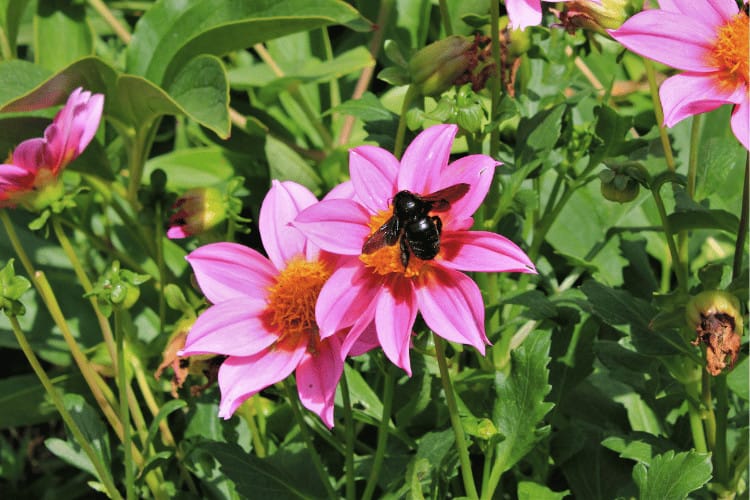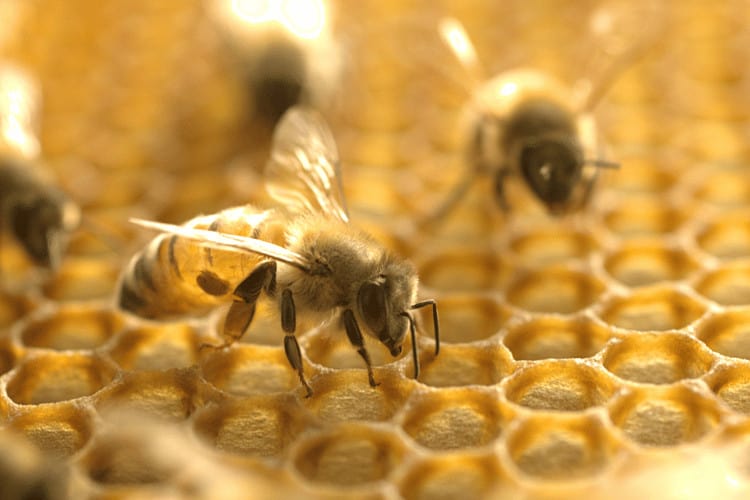Carpenter vs. Honey Bee: Key Differences to Keep in Mind
Hey there, fellow bee enthusiasts!
If you’re diving into the world of beekeeping or just getting your feet wet, you’ve probably come across these two bee buddies: carpenter bees and honey bees.
They might seem like just regular bees at first glance, but trust me, there’s a world of difference buzzing beneath the surface as far as appearance, nesting habits, pollination, and more.
Let’s put on our beekeeping hats and explore the ins and outs of these fascinating insects
Carpenter vs. Honey Bee: Primer

When we talk about carpenter bees, we’re entering the world of solitary flyers. Carpenter bees, known for their shiny abdomens, are all about independent living.
Unlike honey bees, which are social insects, female carpenter bees are the queens of their own castles. They don’t play well with others, preferring to go solo when it comes to nesting sites.
On the other hand, honey bees are lively buzzers that prefer to live in colonies and are all about teamwork. You’ve got the queen bee holding court, surrounded by her female worker bees, and they are the backbone of the hive.
They’re a busy bunch, flying in and out of their hive, collecting nectar from flowers, and turning it into that liquid gold we know as honey.
Carpenter vs. Honey Bee: Key Differences
Now that you know a little bit about carpenter bees and honey bees, let’s talk about the primary differences between these bee species.
Nesting
Carpenter bees are the architects of the bee kingdom. These bees are all about going their own way when it comes to nesting. These mavericks carve out their homes in wooden structures, be it the eaves of houses or the bark of trees.
Female carpenter bees get their creative juices flowing as they chew and tunnel into the wood, crafting cozy nests for their offspring.
Each momma bee has her own space; she fills it with provisions for her larvae before sealing it off. Males might hang around, making some noise and surveying the area, but they don’t really contribute much to the nesting process.
Honey bees, in contrast, are the ultimate team players when it comes to nesting. They create intricate hives, with distinct roles for each member.
The queen bee, the matriarch, lays eggs, while the female worker bees manage all of the hive’s functions. Male drones loiter around, waiting for their moment of action.
Honey bees put lots of effort into building comb structures using wax secreted from their bodies. These structures house the brood—the baby bees—and store honey and pollen.
Pollination
Both carpenter bees and honey bees are excellent pollinators. They play a very important role in our ecosystem by transferring pollen from flower to flower, helping plants to reproduce.
Here’s a fun fact, though!
Honey bees have a special technique that’s called “buzz pollination.” They vibrate their wings at a specific frequency, causing flowers to release pollen, which they then gather and take back to their hive.
Carpenter bees, though not as skilled in this technique, still do a commendable job of pollinating our green friends using their hairy abdomens.

Sting
Alright, let’s talk about the elephant in the room: bee stings. We all know bee stings can be a real buzzkill, but it’s interesting to note that only female bees can sting.
Honey bee stingers are barbed, which means they get stuck in your skin after a sting—ouch! This usually leads to the bee’s demise.
Carpenter bees, however, have a smoother sting operation and rarely sting humans. They’re pretty chill that way.
Appearance
When it comes to appearances, carpenter bees and honey bees have their own unique styles.
Carpenter bees are the sleek black bombers of the bee world. Their bodies are entirely black, with shiny abdomens that catch the sunlight just right.
On the other hand, honey bees sport a more vibrant look. They’re known for their classic black and yellow stripes that adorn their abdomens. Also, their thoraxes are covered in a fuzz of hair, giving them a distinct texture.
These stripes, along with their fuzzy thoraxes, are like a signature style that honey bees rock as they zip around gathering nectar and pollen.
So, if you’re ever trying to spot the difference between these two bee species, take a moment to check out their outfits; carpenter bees in their sleek black ensembles and honey bees with their snazzy black and yellow stripes.
Behavior
Carpenter bees and honey bees might both buzz around in the same pollination game, but their behavior couldn’t be more distinct.
Carpenter bees are like the independent artists of the bee world. They’re quite solitary, and the females are the stars of the show.
These ladies prefer a “me, myself, and I” lifestyle, carving their own nests in wooden structures. While they might get a tad territorial around their nesting sites, they’re generally pretty chill and rarely sting humans.
Honey bees, on the other hand, are the ultimate team players. They’re social insects that live in well-organized colonies.
Honey bees have this intricate method of communication called the waggle dance. It’s how they share info about food sources. Think of it as their version of GPS directions!
Honey

Carpenter bees don’t engage in honey production as honey bees do. These resourceful insects collect nectar from flowers primarily for their own consumption, using it as a source of energy.
However, they don’t possess the sophisticated organizational structure needed for mass honey production. Instead, carpenter bees focus on their solitary lifestyles, channeling their energy into nesting and survival.
Honey bees, on the other hand, are the rock stars of honey production. These diligent creatures work together as a highly organized unit to create the liquid gold we all know and love.
Honey bees collect nectar from flowers and transform it into honey through enzymatic digestion, evaporation, and storage within the hive’s hexagonal wax cells.
This honey serves as their primary food source, especially during colder months when foraging becomes challenging.
To put it simply, while carpenter bees gather nectar for personal sustenance, honey bees take nectar to a whole new level by converting it into honey on an impressive scale, benefiting both their own hive and us as appreciative consumers of their delectable creation.
FAQs
1. Are carpenter bees harmful to structures?
Answer: Yes, carpenter bees can potentially harm structures. While they typically don’t cause extensive damage like termites, their habit of burrowing into wood to create nests can weaken the wood over time. This can lead to structural vulnerabilities and the need for repairs.
2. Do carpenter bees sting?
Answer: Female carpenter bees do have stingers, but they are generally non-aggressive and rarely sting unless they feel threatened or cornered.
They’re more likely to hover around intruders as a means of intimidation rather than engaging in direct attacks. Male carpenter bees, however, lack stingers and are harmless.
3. How can I deter carpenter bees from nesting on my property?
Answer: To deter carpenter bees, consider painting or staining exposed wooden surfaces. Carpenter bees prefer untreated or weathered wood, so maintaining a fresh coat of paint or sealant can discourage them.
Filling existing holes with wood filler and applying aromatic repellents like citrus oils or certain wood finishes can also make these areas less attractive for nesting.
4. What is the importance of honey bees?
Answer: Honey bees play a vital role in pollinating crops that make up a significant portion of the world’s food supply.
Their pollination services contribute to the reproduction of fruits, vegetables, nuts, and other plants. This process supports global food production and enhances ecosystem health.
5. Can honey bees only produce honey?
Answer: Honey bees are multifaceted creatures. While they are known for producing honey, they also create other valuable substances.
Beeswax is used to build their honeycomb, royal jelly nourishes bee larvae, and propolis is a resinous mixture that seals gaps in the hive and protects against pathogens. These products contribute to the hive’s functionality and overall health.
6. Are honey bees aggressive?
Answer: Honey bees are generally docile and peaceful insects. They only sting when they perceive a direct threat to their hive or themselves.
When foraging for nectar away from the hive, they are unlikely to sting unless provoked or mishandled. It’s important to approach them calmly and avoid sudden movements around their hive.
Wrapping Up
In the buzzing world of bees, the contrast between carpenter bees and honey bees couldn’t be clearer. These two remarkable species showcase the diversity of nature’s designs.
Carpenter bees, the solitary insects, craft their wooden sanctuaries with elegance, while honey bees, the social artisans, collaborate harmoniously to produce honey and sustain their hive communities.
Through distinct nesting habits, foraging behaviors, and agricultural roles, these bees remind us that every species, no matter how small, plays a vital role in maintaining the delicate balance of our ecosystem.
So, whether you’re drawn to the independence of carpenter bees or the hive’s collective buzz of honey bees, both remind us of the awe-inspiring complexity and beauty of our natural world.
